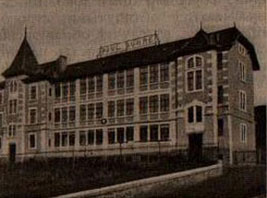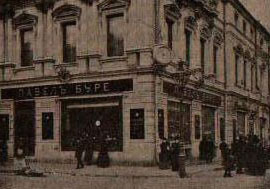@thepocketwatchman
Hi comrades.
Today, I shall feature what I consider to be a very special watch indeed. It is not a Soviet-era watch, rather a worthy representative of White Russia (if you have read Tolstoy, you will know what I mean).
Normally, Russian watch enthusiasts tend to pay attention to the brands and watches manufactured during the Soviet period. In today’s post, however, I look further back. The focus is on one of the oldest watch manufactures in Russia. In fact, the protagonist of this article its one of the first wristwatches ever made. It is a Pavel Buhre.

Pavel Buhre is totemic in the world of Russian watchmaking. It could easily be argued that it is the most prestigious watchmaker the country has seen. Let’s examine a bit of its history.

This watchmaking house began its life in St. Petersburg in 1815, with Karl Buhre at the helm. Pavel Karlovich Buhre Jr. inherited the business, on his father’s death. He was very well connected with the imperial court of Tsar Nicholas I. In turn, his eldest son, Pavel Pavlovich Buhre, who graduated from Petropavlovsk Commercial College, partnered his father at the age of 26, in 1868. Soon after, in 1874, and in an unprecedented move for the time, the family acquired a watch factory in the Swiss city of Le-Locle.


From this base, the firm began larger scale manufacturing of movements and fittings for export across Europe and obviously to secure a good share of the Russian market, where there was competition from brands such as Heinrik Khan, Otto Hafeli, Henry Mosser… Within Russia, workshops assembled the watches from these components. Soon, Pavel Buhre pocket watches became very successful (he patented a chronograph, among other things) and the firm opened a large store in Kiev, and then another in Moscow, to sell the watches.
In 1899, Pavel Buhre was granted the privilege of becoming the Official Supplier of the Imperial House, an honour preserved until the fall of the Romanov dynasty. During those years, the Pavel Buhre brand won a number of medals and exhibition prizes, such as the Gold Medal in the Universal Exhibition of Paris in 1900, as can be seen in the bulletin of the ¨Fédération Horlogére Suisse¨ for said year, displayed below.

These successes, and of course being the official provider to the Russian royal family, enabled Pavel Buhre watches to become widely known and used in Tsarist Russia. Part of this success stemmed from the company’s great commercial vision, with the firm creating watches for all social classes; their prices started from as low as 2 roubles, making them accessible to ordinary workers, while the upmarket offerings would cost thousands of roubles and were presented in gold metal cases, with high-end complications, diamond settings, etc., for the higher echelons of the Court. Some of these haute horlogerie pieces can still be admired in The Kremlin Museum.



Pavel Buhre creations tend to appear in all exhibitions devoted to Russian watchmaking, such as the example below on occasion of the 240th anniversary of Russian watchmaking, held in Moscow.

Now let’s take a look at our protagonist.

The first thing that caught my attention is its the size, at 36 mm across, without the crown. It is definitely not small for the period, yet many Russian watch enthusiasts are accustomed to encountering something akin to the big Type 1. The case is silvered, and the ceramic dial is in very good condition. The numerals are Roman and the number 12 is framed in red.
The watch is a pocket watch-type with fixed lugs. It incorporates a double back cover, the innermost being hinged. On the inside of the inner back cover we find the serial number, which corresponds to a watch produced in 1917. This is of significance, of course, because it is likely to be among the last Pavel Buhre watches marked as ¨made in Russia¨. The following series is represented by watches that were made in Riga, following the October 1917 Revolution.

When you come across a watch like this, it is very easy to think that is it a Frankenstein pocket watch turned into a wristwatch (commonly known as a marriage watch) or a trench watch… In this case, and rather fortunately for me, a 1913 catalogue shows that the piece is in fact an original wristwatch. The document offers a lot of additional, and valuable, information.

First, we can ascertain that it is really a wristwatch, leaving the factory in this form, and that it was priced at 30 roubles. This sum was not exactly negligible at the time. For example, the contemporaneous salary of a low-ranking officer in the army (a lieutenant, say) was about 50 roubles per month. It would only be fair to add that it was hardly an extraordinary sum of money for the period. Thus, It would appear to have been priced as a quality, yet affordable, piece. For reference, you can view an amazing article about the standard (and cost) of living in both Moscow and St. Petersburg in the pre-revolution era.
In the following exhibit, from the same catalogue, we can see and compare the watch to the ladies’ watch offerings, also in wristwatch form (as observed in the left hand side column of the page).

The movement is the beautiful manufacture H5.45, with 13 jewels, that retains amazing accuracy to this day. The specifications of the caliber can be seen in this additional document.
Inside the outer back cover, we find what I consider to be the cornerstone of this watch, which is he emblem of the Imperial House and the inscription Official Supplier of his Majesty.

You might have guessed that the October 1917 Revolution resulted in an abrupt end of Pavel Buhre as a going concern. The firm lost its retail stores and its manufacturing buildings were absorbed by Gostrest Tochmeh, or the State Trust of Precision Mechanics, controlled by the Soviet administration. This is evidently of interest too, but I propose to cover it in a future post.

Thank you so much for you attention.

Este creo que no lo he visto. Que no falte en la siguiente quedada, por favor.
Por supuesto. No es de los que salgan más a la calle por su antigüedad y exclusividad.
I cant wait for the next chapter!
Estoy en ello. 🙂
Miquel, el artículo muy interesante para aprender. He tenido el placer de poder ponérmelo un día que lo trajiste. Esperamos el siguiente capítulo.
Un article ben interessant. Sempre és un gust llegir-los i sempre aprenc moltes coses. Esper sa continuació.